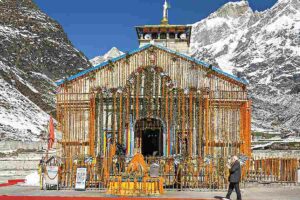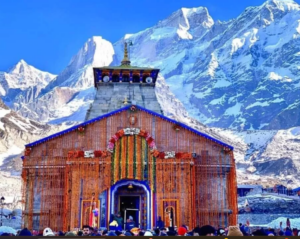Kedarnath Temple: A Spiritual Haven Amidst the Himalayas.

Nestled in the lap of the majestic Himalayas, the Kedarnath Temple stands as a testament to both the resilience of faith and the breathtaking beauty of nature. This ancient shrine, dedicated to Lord Shiva, holds a rich history dating back thousands of years, attracting devotees and travelers from all corners of the globe. However, amidst its serene surroundings lies a tale of destruction and rebirth, marked by a catastrophic flood that shook the region in 2013.
The history of Kedarnath Temple traces back to Hindu mythology, where it is believed to have been built by the Pandavas, the protagonists of the epic Mahabharata. Legend has it that after the great war, the Pandavas sought the blessings of Lord Shiva to absolve themselves of the sins committed during battle. Pleased with their devotion, Lord Shiva appeared as a bull, and upon being followed by the Pandavas, he disappeared into the ground, leaving behind his hump at Kedarnath. Thus, the temple was constructed at this sacred site, enshrining the divine presence of Lord Shiva.
Over the centuries, Kedarnath Temple has undergone numerous renovations and restorations, evolving into the magnificent structure it is today. Perched at an altitude of 3,583 meters (11,755 feet) above sea level, the temple offers breathtaking panoramic views of the surrounding peaks, making it not only a spiritual destination but also a haven for nature lovers and adventurers.
However, the tranquility of Kedarnath was shattered on June 16, 2013, when a devastating flash flood wreaked havoc in the region. Heavy rainfall and cloudbursts triggered landslides and overflowing rivers, causing massive destruction to infrastructure and claiming thousands of lives. The floodwaters engulfed the town of Kedarnath, submerging homes, hotels, and shops, and leaving behind a trail of devastation.
In the aftermath of the disaster, the Kedarnath Temple stood miraculously undamaged, emerging as a symbol of hope and resilience amidst the rubble. The restoration efforts that followed were monumental, with authorities and volunteers working tirelessly to rebuild the infrastructure and revive the pilgrimage routes. Today, Kedarnath stands as a shining example of human perseverance and the enduring power of faith.

For travelers planning a visit to Kedarnath, the best time to undertake the journey is during the summer months, from May to June, and the autumn months, from September to October. During these periods, the weather is relatively mild, and the pilgrimage routes are accessible, allowing for a comfortable and enjoyable experience.
It is important to note that Kedarnath Temple remains open only for a few months each year, due to the extreme weather conditions prevalent in the region. The temple gates, known as “Kapat,” are traditionally opened on the auspicious day of Akshaya Tritiya, which falls in the Hindu month of Vaishakha (April-May). The closing date of the temple, known as the “Kapat Bandh,” varies each year and is determined by the Hindu calendar. Typically, the temple gates are closed around the time of Diwali, marking the onset of winter and the onset of heavy snowfall in the region.
In conclusion, Kedarnath Temple stands as a timeless beacon of spirituality and natural beauty, drawing pilgrims and travelers alike to its hallowed grounds. Despite facing adversity in the form of natural disasters, the temple continues to inspire awe and reverence, serving as a reminder of the indomitable spirit of the human soul. Whether seeking solace in prayer or marveling at the wonders of nature, a journey to Kedarnath is an experience like no other, leaving an indelible mark on the hearts and minds of all who visit.